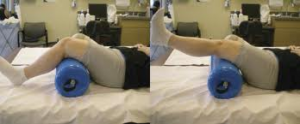Healthy Life: Knee Extension Exercises (629-2)
Healthy Life: Knee Extension Exercises
The most important muscle in the knee is the quadriceps medialis or vastus medialis. When the knee is injured, this muscle on the inside of the knee is usually affected and unable to exert its power. In addition, it will affect the knee in such a way that it cannot straighten fully. Atrophy will generally be the result in this muscle. All these conditions will cause the knee, especially the knee cap (patella), to degenerate earlier than normal.
Moreover, this will cause an unbalanced increase in strength in the quadriceps lateralis on the outside. Degeneration will worsen if early intervention is not administered. When it starts to affect daily activities then surgery is inevitable.
Therefore, it is very important to strengthen the quadriceps medialis in any kind of knee injuries. Below are two common exercises for the muscles. However, if the knee injury is complicated or there is unfavourable effect then exercises must be stopped and help sought from physiotherapist.

shapefit.com
The first exercise focuses on the last 15 degrees of extension or full straightening of the knee. This will lock the patella and is very important in many daily activities that involve the knee. If the knee cannot be fully extended, the quadriceps medialis will definitely atrophy and the knee cap will have early degeneration. Climbing stairs will be difficult and painful.
Roll two or more towels up and place them underneath the knee to provide a fulcrum for focus of muscle action at the quadriceps medialis and to cut out unfavourable muscle action in the hip flexors. Straighten up the knee and lift the heel off the floor or couch (see figure below). Hold the contraction of the quadriceps medialis for a count of 10 or 10 seconds. Then slowly let the heel down. 10 repetitions four times a day is the right dosage. As the muscle strength improves, resistance can be added in the form of ankle weights from one to two kilograms for the general population. For atheletes, higher weights are necessary but the appropriate weight resistance should be given by physiotherapist after individual assessment.

blog.advancedprostheticscenter.com
The second exercise goes through a fuller range of movement. Sitting with back supported by a chair or use your hands at the back to support the upper body so that the exercise will not cause back pain especially for people with previous back problems.
Same as the first exercise: Straighten up the knee (see figure below) and hold the contraction of the quadriceps medialis for a count of 10 or 10 seconds. Then slowly lower the leg down. 10 repetitions four times a day is the right dosage.

weightlossingidea.com
